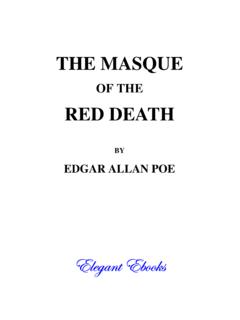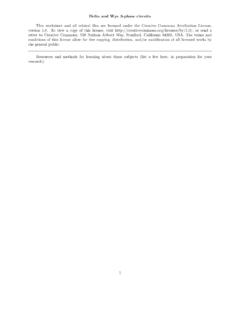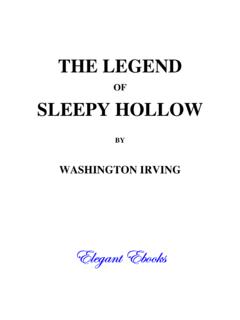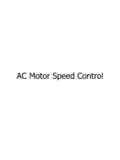Transcription of AC motor control circuits - ibiblio
1 AC motor control circuits This worksheet and all related files are licensed under the Creative Commons Attribution License, version To view a copy of this license, visit , or send a letter to Creative Commons, 559 Nathan Abbott Way, Stanford, California 94305, USA. The terms and conditions of this license allow for free copying, distribution, and/or modification of all licensed works by the general public. Resources and methods for learning about these subjects (list a few here, in preparation for your research): 1. Questions Question 1. An alternative to the conventional schematic diagram in AC power control systems is the ladder diagram. In this convention, the hot and neutral power conductors are drawn as vertical lines near the edges of the page, with all loads and switch contacts drawn between those lines like rungs on a ladder: To 480. VAC. "Hot" Fuse "Neutral". 120 VAC.
2 Toggle switch Indicator light Limit switch Solenoid coil Temperature switch As you can see, the symbolism in ladder diagrams is not always the same as in electrical schematic diagrams. While some symbols are identical (the toggle switch, for instance), other symbols are not (the solenoid coil, for instance). Re-draw this ladder diagram as a schematic diagram, translating all the symbols into those correct for schematic diagrams. file 00832. 2. Question 2. Perhaps the most challenging aspect of interpreting ladder diagrams, for people more familiar with electronic schematic diagrams, is how electromechanical relays are represented. Compare these two equivalent diagrams: First, the ladder diagram: To 480. VAC. L1 L2. 120 VAC. Toggle switch M1. M1 motor Next, the schematic diagram: "Hot". Relay (M1). To 480. VAC. Mtr "Neutral". Based on your observations of these two diagrams, explain how electromechanical relays are represented differently between ladder and schematic diagrams.
3 File 00833. 3. Question 3. Draw the necessary wire connections to build the circuit shown in this ladder diagram: Ladder diagram: L1 L2. Toggle switch M1. M1 motor Illustration showing components: Toggle switch (SPDT). L1 L2. Relay motor (Dashed lines represent connections between relay terminals and socket screw lugs, hidden from sight). Yes, the Run switch shown in the diagram is a SPST, but the switch shown in the illustration is a SPDT. This is a realistic scenario, where the only type of switch you have available is a SPDT, but the 4. wiring diagram calls for something different. It is your job to improvise a solution! file 00836. Question 4. Interpret this AC motor control circuit diagram, explaining the meaning of each symbol: L1 L2. Run M1. M1. To 3-phase motor power source Also, explain the operation of this motor control circuit. What happens when someone actuates the Run switch?
4 What happens when they let go of the Run switch? file 00834. Question 5. Interpret this AC motor control circuit diagram, explaining the meaning of each symbol: L1 L2. Run M1. M1. M1. To 3-phase motor power source Also, explain the operation of this motor control circuit. What happens when someone actuates the Run switch? What happens when they let go of the Run switch? file 00835. 5. Question 6. A very common form of latch circuit is the simple start-stop relay circuit used for motor controls, whereby a pair of momentary-contact pushbutton switches control the operation of an electric motor . In this particular case, I show a low-voltage control circuit and a 3-phase, higher voltage motor : To 3-phase power source F1. F2. L1 L2. Start Stop M1. M1. M1. motor Explain the operation of this circuit, from the time the Start switch is actuated to the time the Stop . switch is actuated.
5 The normally-open M1 contact shown in the low-voltage control circuit is commonly called a seal-in contact. Explain what this contact does, and why it might be called a seal-in contact. file 01347. 6. Question 7. Draw the necessary wire connections to build the circuit shown in this ladder diagram: Ladder diagram: L1 L2. Start M1. M1. M1 motor Illustration showing components: 7. L1 L2. Relay motor (Dashed lines represent connections between relay terminals and socket screw lugs, hidden from sight). file 00838. 8. Question 8. Identify at least one fault that would cause the motor to turn off immediately once the Start . pushbutton switch was released, instead of latch in the run mode as it should: To 3-phase power source F1. T1 F2. L1 L2. Start Stop M1. M1. M1. motor For each of your proposed faults, explain why it will cause the described problem. file 03896. 9. Question 9.
6 Examine this three-phase motor control circuit, where fuses protect against overcurrent and a three-pole relay (called a contactor) turns power on and off to the motor : Schematic Fuse Fuse Fuse diagram Fuses 1 2 3. 1 2 3. motor motor 3 2 1. Shaft 1 2 3 Contactor 1 2 3. After years of faithful service, one day this motor refuses to start. It makes a humming sound when the contactor is energized (relay contacts close), but it does not turn. A mechanic checks it out and determines that the shaft is not seized, but is free to turn. The problem must be electrical in nature! You are called to investigate. Using a clamp-on ammeter, you measure the current through each of the lines (immediately after each fuse) as another start is once again attempted. You then record the three current measurements: Line Current 1 amps 2 amps 3 0 amps Determine at least two possible faults which could account for the motor 's refusal to start and the 10.
7 Three current measurements taken. Then, decide what your next measurement(s) will be to isolate the exact location and nature of the fault. file 03623. Question 10. There is something wrong in this motor control circuit. When the start button is pressed, the contactor energizes but the motor itself does not run: Schematic Fuse Fuse Fuse diagram Fuses 1 2 3. 1 2 3. motor motor 3 2 1. Shaft 1 2 3 Contactor .. To 1 2 3 control circuit Identify a good place to check with your multimeter to diagnose the nature of the fault, and explain your reasoning. file 03828. 11. Question 11. Working on a job site with an experienced technician, you are tasked with trying to determine whether the line currents going to a three-phase electric motor are balanced. If everything is okay with the motor and the power circuitry, of course, the three line currents should be precisely equal to each other.
8 The problem is, neither of you brought a clamp-on ammeter for measuring the line currents. Your multimeters are much too small to measure the large currents in this circuit, and connecting an ammeter in series with such a large motor could be dangerous anyway. So, the experienced technician decides to try something different he uses his multimeter as an AC milli-voltmeter to measure the small voltage drop across each fuse, using the fuses as crude shunt resistors: mV. V A. V OFF. A. Fuse Fuse Fuse A COM. He obtains the following measurements: Line Fuse voltage drop 1 mV. 2 mV. 3 mV. Do these voltage drop measurements suggest imbalanced motor line currents? Why or why not? file 03624. 12. Question 12. Identify at least three independent faults that could cause this motor not to start: To 3- , 480 volt power source L1 L2 L3 L1 L2 L3. Schematic diagram Fuses Transformer Transformer H4.
9 X2. H2. H3 Contactor H1 H3 H2 H4. X1. H1. Contactor A1 X1 X2. A2 A2 A1. T1 T2 T3. Switch motor motor Switch T1 T2 T3. For each of the proposed faults, explain why they would prevent the motor from starting. file 03829. 13. Question 13. A special type of overcurrent protection device used commonly in motor control circuits is the overload heater. These devices are connected in series with the motor conductors, and heat up slightly under normal current conditions: L1 L2. Run M1 OL. M1 OL. To 3-phase motor power source Although the heater elements are connected in series with the motor lines as fuses would be, they are not fuses! In other words, it is not the purpose of an overload heater to burn open under an overcurrent fault condition, although it is possible for them to do so. The key to understanding the purpose of an overload heater is found by examining the single-phase (L1.)
10 / L2) control circuit, where a normally-closed switch contact by the same name ( OL ) is connected in series with the motor relay coil. How, exactly, do overload heaters protect an electric motor against burnout from overcurrent conditions? How does this purpose differ from that of fuses or circuit breakers? Does the presence of overload heaters in this circuit negate that need for a circuit breaker or regular fuses? Explain your answers. file 00837. 14. Question 14. The circuit shown here provides two-direction control (forward and reverse) for a three-phase electric motor : L1 L2. Forward M2 M1 OL. Reverse M1 M2. M1 OL. To 3-phase motor power source M2. Explain how the reversal of motor direction is accomplished with two different motor starters, M1 and M2. Also, explain why there is only one set of overload heaters instead of two (one for forward and one for reverse).









![[9] - ibiblio.org](/cache/preview/5/5/7/d/7/8/c/5/thumb-557d78c5e5b7e50924ac9fa19b799cb0.jpg)






